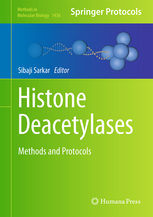Researcher Edits New Volume of Methods in Molecular Biology on HDACs
 Sibaji Sarkar, PhD, an instructor of medicine at BUSM, has edited the textbook Histone Deacetylases (HDAC): Methods and Protocols. Part of a series titled “Methods in Molecular Biology,” this recent edition published by Springer provides methods and procedures for molecular biology, genetics and epigenetics research.
Sibaji Sarkar, PhD, an instructor of medicine at BUSM, has edited the textbook Histone Deacetylases (HDAC): Methods and Protocols. Part of a series titled “Methods in Molecular Biology,” this recent edition published by Springer provides methods and procedures for molecular biology, genetics and epigenetics research.
HDACs are part of a vast family of enzymes that have crucial roles in numerous biological processes. One of the major roles is to close chromatin structure to inhibit gene expression. HDAC inhibitors are now extensively studied to develop novel drugs for cancer, cardiovascular diseases, metabolic syndromes and neurological disorders. This volume offers different methodologies for all classes of HDACs, which includes detailed procedures on Class I and II histone deacetylases and their inhibitors, SIRT inhibitors and bromodomain inhibitors.
Divided into four sections: Sections A and B describe methodologies used to detect the activity, function, or chromatin location of HDACs 1 through 11, with Section A discussing Class I and Section B discussing class II histone deacetylases; Section C focuses on the methodologies for cloning and characterizing the acetylation of SIRTs 1 through 7; and Section D describes methods related to histone deacetylase inhibitors.
Each chapter includes introductions to their respective topics, lists of the necessary materials and reagents, step-by-step readily reproducible laboratory protocols and tips on troubleshooting and avoiding known pitfalls.
According to Sarkar investigators working on epigenetics, molecular biology, genetics and drug development will find this book a valuable resource.
View all posts